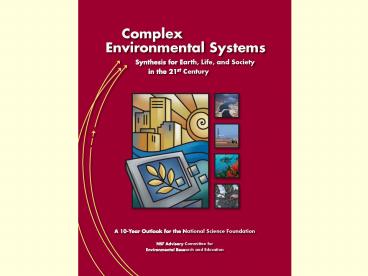Executive Summary PowerPoint PPT Presentation
1 / 29
Title: Executive Summary
1
(No Transcript)
2
Executive Summary
- As the global footprint of human activity
continues to expand, environmental science and
engineering problems will provide great
challenges and opportunities in the next decade.
Because of the complex relationships among
people, ecosystems, and the biosphere, human
health and well-being are closely linked to the
integrity of local, regional, and global
ecosystems. Therefore, environmental research and
education are central elements of local,
national, and global security, health, and
prosperity.
3
- New instrumentation, data-handling, and
methodological capabilities have expanded the
horizons of what we can study and understand
about the environment. These advances create the
demand for collaborative teams of engineers and
natural and social scientists that go beyond
current disciplinary research and educational
frameworks.
4
- To meet these complex challenges as well as
urgent human needs, we need to develop
environmental synthesis to frame integrated
transdisciplinary research questions and
activities and to merge data, approaches, and
ideas across spatial, temporal, and societal
scales.
5
- Fundamental research on the environment includes,
integrates, and builds on the physical, chemical,
biological, and social sciences, mathematics, and
engineering. The present and future challenges
include connecting across disciplines and scales,
supporting synthesis studies and activities, more
tightly linking science, technology, and decision
making, and achieving predictive capability where
possible. Many of these issues go beyond current
disciplinary research and educational frameworks
and will require new funding and institutional
approaches.
6
NEON
7
What is it ?
NEON will be a continental scale research
instrument consisting of geographically
distributed infrastructure, networked via
state-of-the-art communications. Cutting-edge lab
and field instrumentation, site-based
experimental infrastructure, natural history
archive facilities and/or computational,
analytical and modeling capabilities, linked via
a computational network will comprise NEON. NEON
will transform ecological research by enabling
studies on major environmental challenges at
regional to continental scales. Scientists and
engineers will use NEON to conduct real-time
ecological studies spanning all levels of
biological organization and temporal and
geographical scales. NSF disciplinary and
multi-disciplinary programs will support NEON
research projects and educational activities.
Data from standard measurements made using NEON
will be publicly available. NSF 2003
8
What is NEON?
- National network of spatially distributed and
high integrated observatories National
Ecological Observatory Network - Each site would contain a core, virtual
laboratory for comprehensive synthetic research
on biological systems. - GOAL help scientists develop a predictive
understanding of the nature and pace of
biological change.
9
NEON
10
So, what is NEON ?
- 500M continental-scale research platform
- NSFs MREFC Account
- Multi-year build-out phase
- 30-year life span
- 2-year design phase, 6M
11
Project Overview
12
Science and Human Dimensions Subcommittees
13
BROAD SCIENCE QUESTIONS
- Biodiversity
- 1) Assessment of current biodiversity, ecosystem
function, and human activities at the levels of
genes, individuals, populations, species, species
assemblages, and landscapes. - 2) Understanding of ecological and evolutionary
processes that determine current patterns of
biological diversity. - 3) Forecasting
- a) change in ecological and evolutionary
processes in response to climate variability and
human activities, - b) impacts of changes in biodiversity (from
genes to landscapes) and human activities on
ecosystem function/services (across space and
time).
14
BROAD SCIENCE QUESTIONS
- Climate Change
- 1) How will variations in climate influence
ecosystem structure and function at landscape to
continental scales? What are the consequences of
these variations for society? - 2) How will these ecosystem variations feed back
to the atmosphere, and to hydrological and
biogeochemical cycles?
15
BROAD SCIENCE QUESTIONS
- Infectious Disease
- 1) Forecast which organisms or types of organisms
are most likely to become health risks or
transmit pathogens to humans, non-human animals,
and plants. - 2) Forecast where and when infectious diseases of
humans, non-human animals, and plants will
emerge.
16
BROAD SCIENCE QUESTIONS
- Invasive Species
- 1) What species are most likely to become
invasive, and how can we manage them? - 2) What are the species and ecosystems at
greatest risk from invasive species, and how can
they be effectively protected?
17
BROAD SCIENCE QUESTIONS
- Land Use
- 1) What are the dynamics and consequences of land
changes, which are coupled human-environment
systems, at regional and continental scales?
18
BROAD SCIENCE QUESTIONS
- Higher Education
- Campus Ecological Observatory Network
- Learning Through Authentic Data
- Open-Door NEON
- Informal Education
- Center for Ecological Lifelong Learning
- K-12 Education
- NEON K-12 Educational Research Agenda
- K-12 Educational Interface
- Learning Communities Initiative
19
Invasive Species
NEON Grand Challenges
Trajectories
Biogeochemical Cycles
Economics
Biodiversity Studies
Political Issues
Climate Change
Cultural Issues
Social System
Ecological System
Local Communities
Hydroecology
(Learning Communities)
(Learning Communities)
Public Health
Land Use
Cyber-Infrastructure (Data Into Knowledge Systems)
Infectious Disease
Other Social Issues
Education
20
(No Transcript)
21
(No Transcript)
22
(No Transcript)
23
(No Transcript)
24
The Challenge Ahead
- Great expectations All things to all people?
- Genes to biosphere, a variety of scientific
disciplines, all scales - High technology
- Human dimensions
- Education
- Diversity
- Stakeholders academics, government, NGOs,
resource managers, policymakers - 5B and counting
25
(No Transcript)
26
(No Transcript)
27
Pacific NEON
HAWAIIAN ISLANDS
28
Pacific Basin Information Node (PBIN)
29
Webpages
- www.neoninc.org
- www.pacificneon.hawaii.edu

